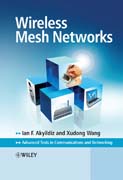
This book presents an in-depth study on recent advances and open research issues in Wireless Mesh Networks (WMNs). It is the first comprehensive textbook on the subject, providing you with an accessible, single-source, definitive resource. System architectures and applications of WMNs are described, followed by discussion of the critical factors influencing protocol design. Theoretical network capacity and the state-of-the-art protocols for WMNs are explored, presenting a number of open research issues. Finally, testbeds, industrial practice, and current standard activities related to WMNs are highlighted. The book is written in an accessible style, including materials such as exercises etc.,to assist learning. INDICE: Contents Preface 1 Introduction 1.1 Network Architecture 1.2 Characteristics 1.3 Application Scenarios 1.4 Critical Design Factors 2 Physical Layer 2.1 Adaptive Coding/Modulation and Link Adaptation 2.2 Directional Antennas and Multi-Antenna Systems 2.2.1 Directional Antenna 2.2.2 Antenna Diversity and Smart Antenna 2.3 Cooperative Diversity and Cooperative Communications 2.4Multi-Channel Systems 2.5 Advanced Radio Technologies 2.5.1 Frequency Agile Radios and Cognitive Radios 2.5.2 Reconfigurable Radios and Software Radios 2.6Integrating Different Advanced Techniques: IEEE 802.11n 2.6.1 The Protocol Reference Model of the Physical Layer 2.6.2 PLCP Sublayer 2.6.3 PMD Sublayer 2.6.4 PLME Sublayer 2.7 Open Research Issues 3 Medium Access Control Layer 3.1 Single Channel MAC Protocols 3.1.1 CSMA/CA Improvements 3.1.2 IEEE 802.11e 3.1.3WMN MAC Based on IEEE 802.11s 3.1.4 TDMA over CSMA/CA 3.1.5 IEEE 802.16 MAC in Mesh Mode 3.1.6 MAC for UWB WMNs 3.1.7 CDMA MAC 3.2 Multi-Channel MAC Protocols 3.2.1 Single-Radio MAC Protocol 3.2.2 Slotted Seeded Channel Hopping (SSCH) MAC 3.2.3 Multi-Radio MAC Protocol 3.2.4 Multi-Radio 2-Phase Protocol 3.2.5 Channel Assignment in the MAC Layer 3.2.6 Dynamic Frequency Selection (DFS) Requirements 3.3 Open Research Issues 4 Network Layer 4.1 Routing Challenges 4.2Design Principles 4.3 Topology Discovery for Routing 4.4 Performance Parameters 4.5 Routing Metrics 4.5.1 Hop-Count 4.5.2 Per-Hop RTT 4.5.3 Per-Hop Packet Pair Delay 4.5.4 Expected Transmission Count (ETX) 4.5.5 Expected Transmissionon a Path (ETOP) 4.5.6 Expected Transmission Time (ETT) and Weighted Cumulative ETT (WCETT) 4.5.7 Effective Number of Transmissions (ENT) 4.5.8 Metric of Interference and Channel-Switching (MIC) 4.5.9 Bottleneck Link Capacity (BLC) 4.5.10 Expected Data Rate (EDR) 4.5.11 Low Overhead Routing Metric 4.5.12 Airtime Cost Routing Metric 4.5.13 Remaining Issues 4.6 Categories of Routing Protocols 4.6.1 Hop-count based routing 4.6.2 Link-level QoS routing 4.6.3 End-to-end QoS routing 4.6.4 Reliability-aware routing 4.6.5 Stability-aware routing 4.6.6 Power-efficient routing 4.6.7 Scalable routing 4.7 Hop-Count Based Routing Protocols 4.7.1 Light client management routing (LCMR) protocol 4.7.2 Orthogonal rendezvous routing (ORR) protocol 4.7.3 HEAT Protocol 4.8 Link-Level QoS Based Routing Protocols 4.8.1 Link Quality Source Routing (LQSR) Protocol 4.8.2 Multi-radio LQSR (MR-LQSR) Routing Protocol 4.8.3 ExOR Routing Protocol 4.8.4 AODV-spanning tree (AODV-ST) protocol 4.9 Interference Based Routing: IRMA 4.10 Routing with Load Balancing 4.11 Routing Based on Residual Link Capacity 4.12 End-to-End QoS Routing 4.12.1 Quality aware routing protocol 4.12.2 RingMesh Routing Protocol 4.12.3 Bandwidth reservation routing protocol 4.13 Reliability Based Routing: Multi-Path Routing 4.13.1 Resilient OpportunisticMesh Routing(ROMER) protocol 4.13.2 Simple Two-Path Routing Protocol 4.13.3 Multi-Path Mesh (MMESH) Routing protocol 4.14 Stability Based Routing 4.15 Scalable Routing 4.15.1 Hierarchical Routing 4.15.2 Geographic Routing 4.16 Multi-Channel Routing Protocols 4.16.1 Joint Channel Assignment and Routing 4.16.2 DistributedJoint Channel and Routing Protocol 4.17 Open Research Issues 5 Transport Layer 5.1 Challenges of a Transport Layer Protocol in Wireless Environments 5.2 Transport Layer Protocols for Multihop Ad Hoc Networks 5.2.1 Protocols for Reliable Data Transport 5.2.2 Protocols for Real-Time Delivery 5.3 Transport Layer Protocols for WMNs 5.3.1 Transport Protocols Based on Hop-by-Hop Control 5.3.2DCCP for WMNs 5.4 Open Research Issues 6 Network Security 6.1 Security Attacks in WMNs 6.2 Counter-Attack Measures 6.3 Security Schemes in Related WirelessNetworks 6.3.1 Security of IEEE 802.11Wireless LANs 6.3.2 Security of IEEE 802.16Wireless MANs 6.3.3 Security of Mobile Ad Hoc Networks 6.4 Security Mechanisms forWMNs 6.4.1 Features and Challenges of A SecureWMN 6.4.2 Security of IEEE 802.11sWMN 6.4.3 Future Directions 6.5 Multi-Layer Design for WMN Security 6.5.1 Research Issues in the Multi-Layer Security 7 Network Control and Management 7.1 Mobility Management 7.1.1 Mobility Management in Related Wireless Networks 7.1.2 Mobility Management in WMNs 7.1.3 Open Research Issues 7.2 Power Management 7.2.1 Power Management in Related Wireless Networks . 7.2.2 Power Management in WMNs 7.2.3 Open Research Issues 7.3 Topology Control and Management 7.3.1 Topology Control and Management in Related Wireless Networks 7.3.2 Topology Control and Management in WMNs 7.4 Timing Synchronization 7.5 Traditional Network Management Functions 8 Network Capacity 8.1 Capacity Analysis 8.1.1 Notations and Terms 8.1.2 Capacity of Ad Hoc Networks without Mobility 8.1.3 Capacity of Mobile Ad Hoc Networks 8.1.4 Capacity of Ad Hoc Networks with Infrastructure Support 8.2 Capacity and Delay Tradeoff 8.2.1 The need of capacity-delay tradeoff 8.2.2 Analytical Models and Definitions 8.2.3 Definitions of Throughput-Delay Optimality 8.2.4 Throughput-Delay Tradeoff in Static Networks 8.2.5 Throughput-Delay Tradeoff in Mobile Networks 8.2.6 Open Research Issues 8.3 Applicability of Asymptotic Capacity Analysis to WMNs 9 Cross-Layer Design 9.1 Motivations of Cross-Layer Design 9.1.1 Layered Design versus Cross-Layer Design 9.1.2 Cross-Layer Design in WMNs 9.2 Cross-Layer Design Protocols and Optimization Algorithms 9.2.1 General Methodology of Cross-Layer Design 9.2.2 MAC/Physical Cross-Layer Design 9.2.3 Routing/MAC Cross-Layer Design 9.2.4 Transport/Physical Cross-Layer Design 9.2.5 Joint Optimization Algorithms Across Multiple Protocol Layers 9.3 Prudent Use of Cross-Layer Design 10 Standards on Wireless Mesh Networks 10.1 Overview of IEEE 802Working Groups forWireless Networks 10.2 Overview of Industry Alliance/Forum for DifferentWireless Technologies 10.3 Standards for MeshedWireless LANs 10.3.1 Overview of IEEE 802.11 Standard Activities 10.3.2 IEEE 802.11s 10.4 Standards for MeshedWireless PANs 10.4.1 Overview of IEEE 802.15 Standard Activities 10.4.2 IEEE 802.15.5 10.4.3 UWB-Based MeshedWireless PANs 10.4.4 Remaining Issues in Standards for Meshed Wireless PANs 10.5 Standards for MeshedWireless MANs 10.5.1 Overview of IEEE 802.16 Standard Activities 10.5.2 IEEE 802.16 Mesh Mode 10.5.3 IEEE 802.16j Bibliography
- ISBN: 978-0-470-03256-5
- Editorial: John Wiley & Sons
- Encuadernacion: Cartoné
- Páginas: 328
- Fecha Publicación: 30/01/2009
- Nº Volúmenes: 1
- Idioma: Inglés
